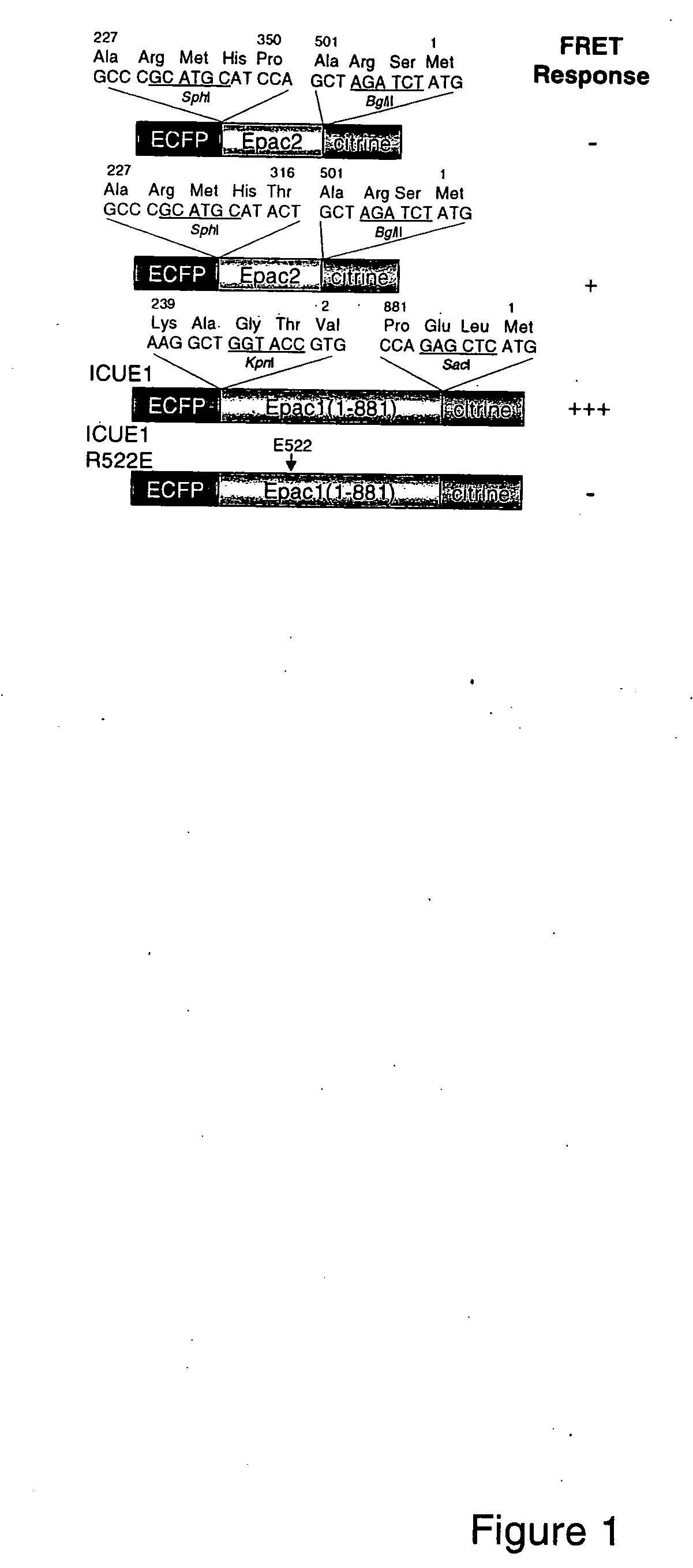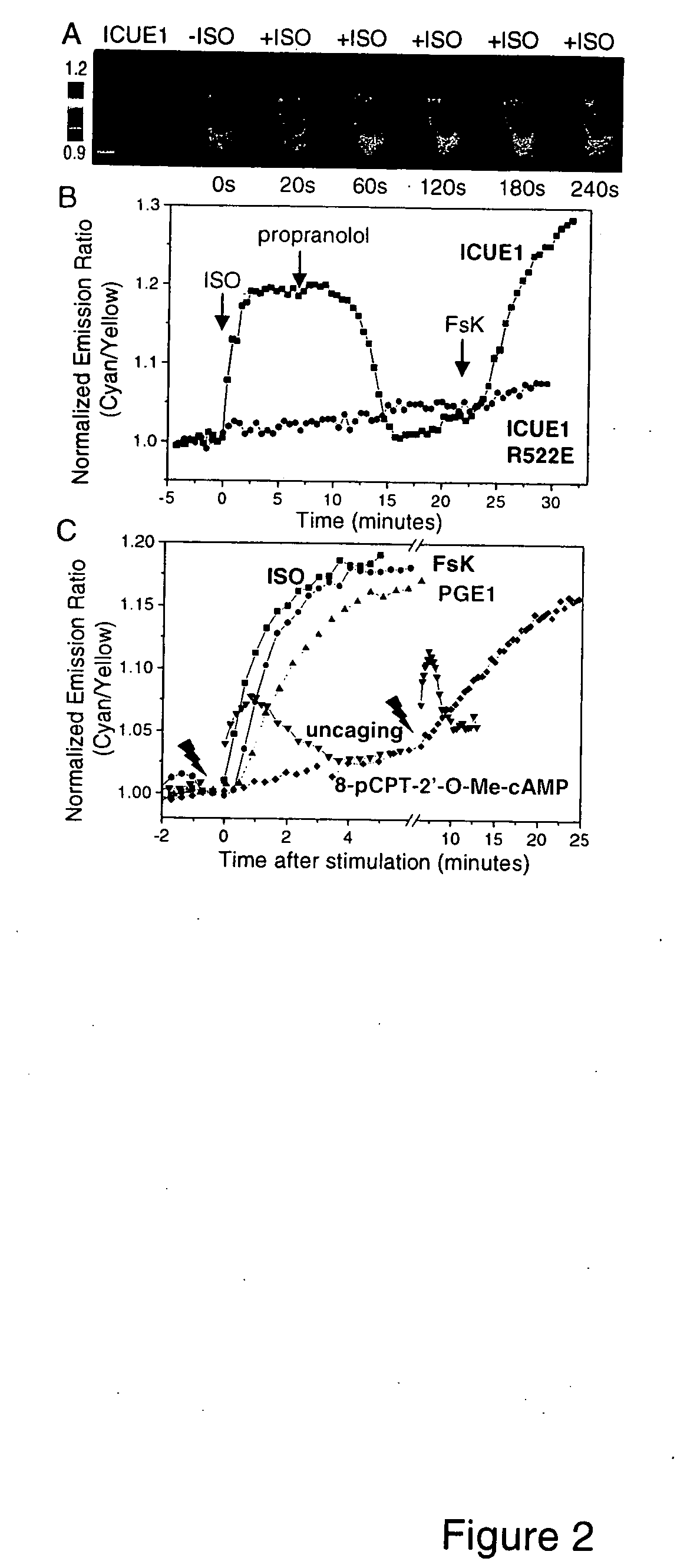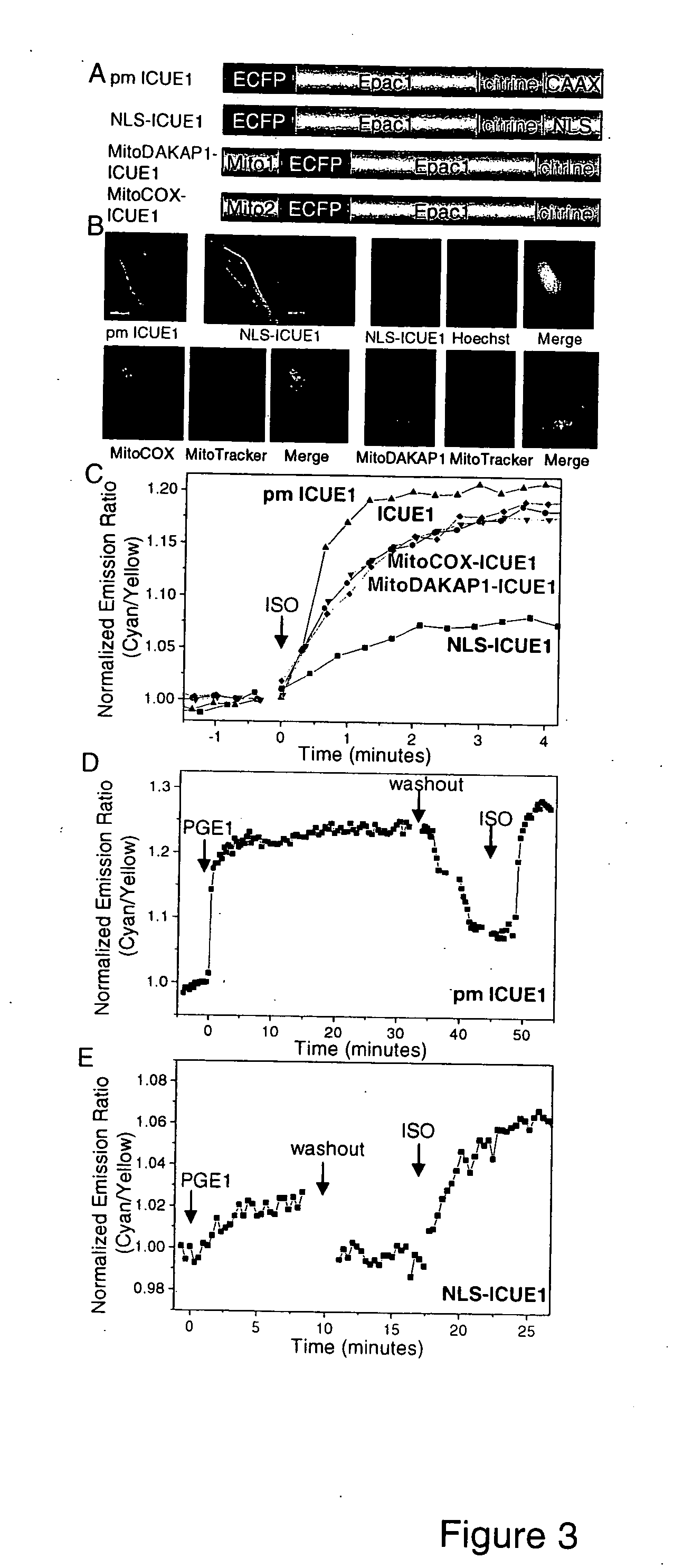cAMP reporters and high throughput assays
a reporter and high throughput technology, applied in the field of detection of camp levels, can solve the problems of poor spatial and temporal resolution, lack of flexibility of measuring camp changes within various subcellular compartments, and no ideally suited monitoring of spatial and temporal distribution of camp in living cells
- Summary
- Abstract
- Description
- Claims
- Application Information
AI Technical Summary
Benefits of technology
Problems solved by technology
Method used
Image
Examples
example 1
Preparation and Function of cAMP Reporters
[0075] We generated a number of proteins by fusing the amino terminus of various Epac truncations to ECFP and the carboxyl terminus to citrine, an improved version of YFP (FIG. 1). Full length Epac1 (1-881, SEQ ID NO:1) and truncated forms of Epac2, T316-A501 (amino acids 316-501 of SEQ ID NO:20) and P350-A501 (amino acids 350-501 of SEQ ID NO:20), were created by PCR using Epac1 (de Rooij et al., Nature 396, 474-77, 1998.) or Epac2 (SEQ ID NO:20; Ozaki et al., Nature Cell Biology 2, 805-11, 2000) as the templates. In one construct, ECFP and citrine were fused together with a domain (amino acids P350-A501 of SEQ ID NO:20) containing the second cyclic nucleotide monophosphate-binding domain from Epac2 and a C-terminal lid (the α-helix that stabilizes the cAMP-binding site) (FIG. 1). Mutation R522E was incorporated by the QUICKCHANGE® method (Stratagene). Enhanced cyan fluorescent protein (ECFP) and citrine were fused to the N and C terminal...
example 2
Cell Culture and Imaging
[0077] Cell Culture. HEK-293, HeLa and PC12 cells were plated onto sterilized glass coverslips in 35 mm dishes and grown to 50-90% confluency in DMEM (10% FBS at 37° C., 5% CO2). Cells were then transfected with FuGENE-6 transfection reagent (Roche) or calcium phosphate and allowed to grow for 12-24 hours before imaging. Colocalization studies were performed by incubating transfected HEK-293 cells with MitoTracker Red 580 or Hoechst 33342 cell-permeable dyes (Molecular Probe) for staining mitochondria or nucleic acids, respectively.
[0078] Imaging. Cells were washed twice with Hanks' balanced salt solution buffer after 12- to 24-h incubation at 37° C. culture medium. Cells were maintained in buffer in the dark at room temperature with addition of isoproterenol (Aldrich), forskolin (Calbiochem), Prostaglandin E1 (PGE1) (Sigma), and 8-(4-chloro-phenylthio)-2′-O-methyl adenosine 3′,5′-monophosphate (8-pCPT-2′-O-Me-cAMP) (Axxora Biolog) as indicated. Cells were...
example 3
Function of cAMP Reporters
[0081] A cAMP reporter in which ECFP and citrine were fused together with a domain (P350-A501; amino acids 350-501 of SEQ ID NO:20) containing the second cyclic nucleotide monophosphate-binding domain from Epac2 and a C-terminal lid was expressed in HEK-293 cells. This reporter showed variable ratios of cyan to yellow emissions which are inversely correlated with expression level of the protein. This concentration dependence indicates intermolecular FRET between different reporter molecules that may occur due to oligomerization or aggregation (Zacharias et al., Science 296, 913-16, 2002). Upon cAMP elevations, this protein did not show a cAMP-dependent FRET change. We incorporated a larger portion of Epac2 sequence N-terminal to the binding domain (T316-A501; amino acids 316-501 of SEQ ID NO:20) (FIG. 1) and obtained a construct that showed more homogeneous emission ratios and a 5% increase in emission ratio of cyan to yellow upon cAMP elevations.
[0082] ...
PUM
| Property | Measurement | Unit |
|---|---|---|
| time points | aaaaa | aaaaa |
| total volume | aaaaa | aaaaa |
| pH | aaaaa | aaaaa |
Abstract
Description
Claims
Application Information
 Login to View More
Login to View More - R&D
- Intellectual Property
- Life Sciences
- Materials
- Tech Scout
- Unparalleled Data Quality
- Higher Quality Content
- 60% Fewer Hallucinations
Browse by: Latest US Patents, China's latest patents, Technical Efficacy Thesaurus, Application Domain, Technology Topic, Popular Technical Reports.
© 2025 PatSnap. All rights reserved.Legal|Privacy policy|Modern Slavery Act Transparency Statement|Sitemap|About US| Contact US: help@patsnap.com



